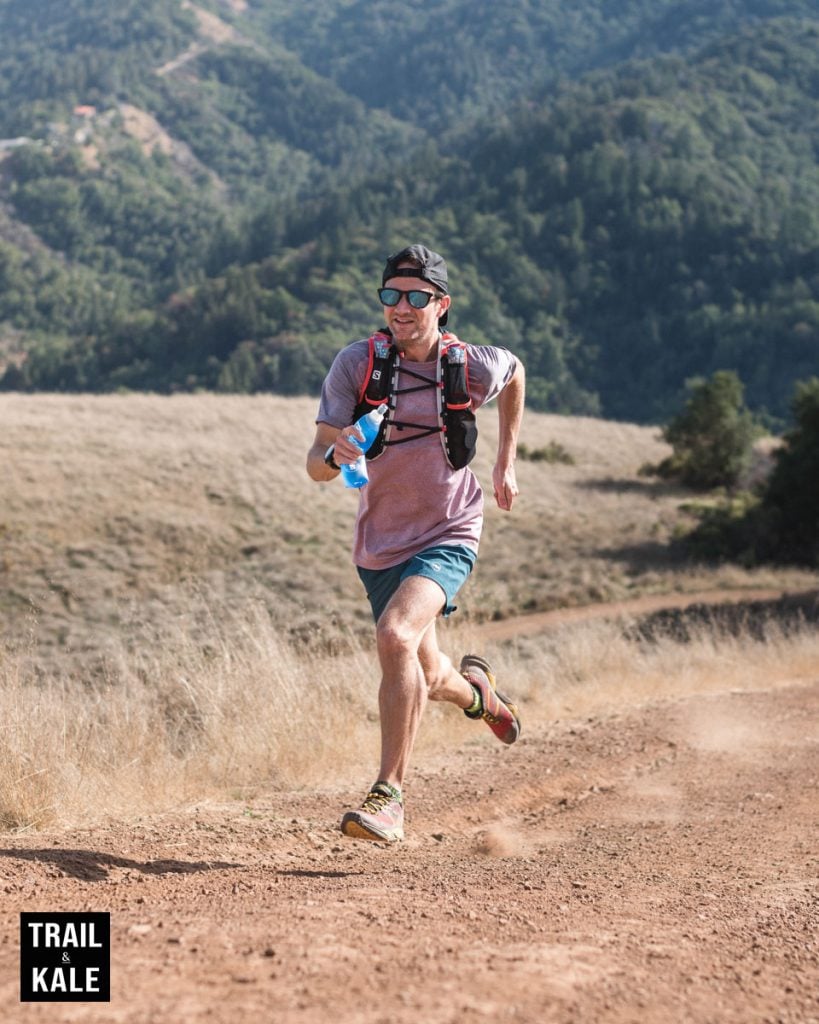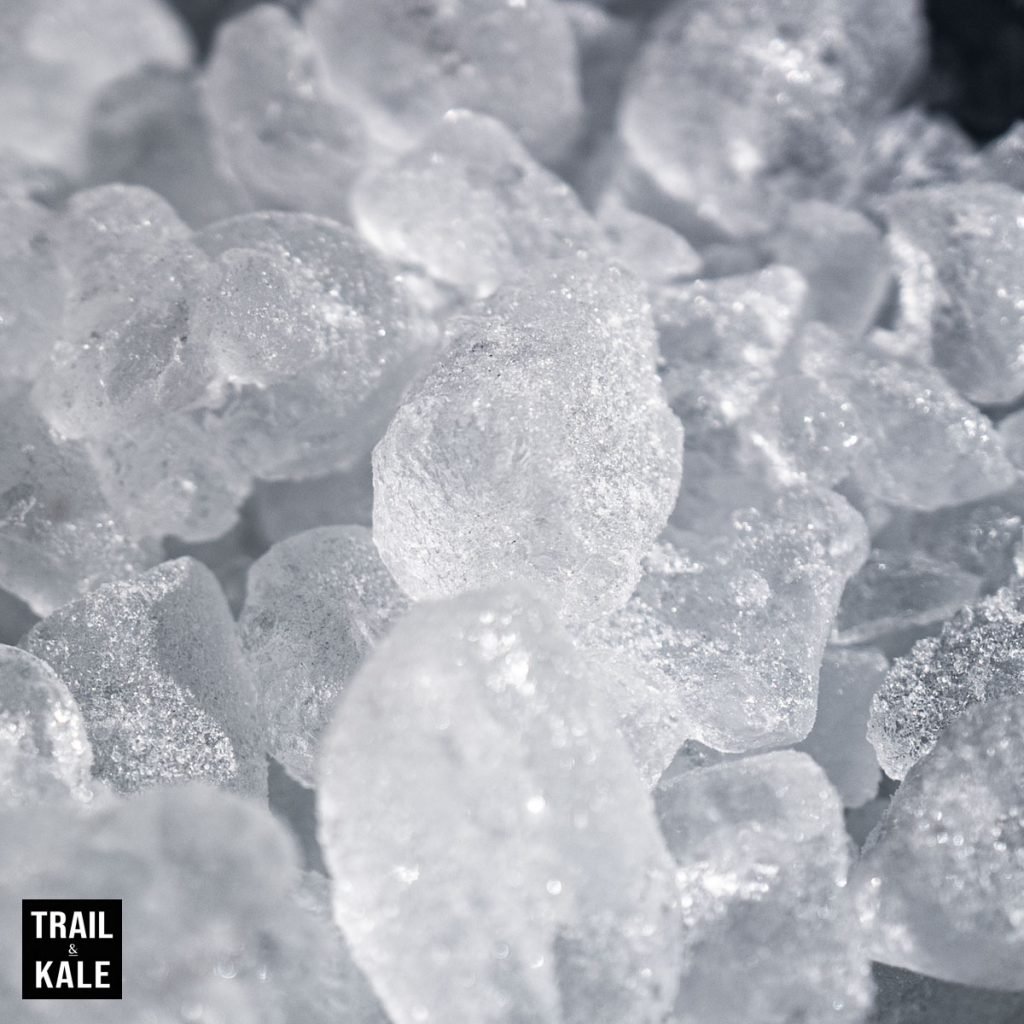If you’ve seen photos and videos of runners sitting in ice baths, then you’ve probably wondered about the benefits of ice baths for runners – and other athletes, for that matter.
While research studies on the subject are fairly limited, it’s widely considered that cold therapy such as taking ice baths provide many benefits, both physically and mentally, with the most commonly cited benefit being a reduction in muscle soreness and faster recovery from hard workouts.
Ice baths (sometimes also called cold water immersion) are a pretty simple concept, and have been done by many people all over the world for athletic recovery as well as general health and wellness benefits.
For example, they’re very popular in certain Nordic countries such as Sweden, where they even have purpose-built cold bath houses to facilitate cold plunging and winter swimming in cold water.
They’re also easy to do at home, so perhaps they’re worth a try. I’ll let you be the judge of that, though, once you’ve read about the benefits and downsides to immersion in ice cold water, before you decide whether to take the ‘plunge’. Yep, I said that 🙂
What is an ice bath?
Basically, taking an ice bath involves immersing your whole body, up to your chest or neck, in cold water.
Contrary to what you may think, you may be pleased to learn that the water does not need to be at an absolutely freezing temperature to provide you with the benefits of cold water therapy.
What’s the best ice bath temperature to use?
The general approach many people take is to get their bath water down to a minimum temperature of 50 to 55 degrees Fahrenheit (10 to 13 degrees Celsius).
That being said, that means we’re still talking about a pretty cold bath and you will likely need ice to get it down to that temperature.
Are ice baths good for you?
Loads of people find ice baths to be a beneficial experience.
However, for people with certain health conditions including heart problems, diabetes and high blood pressure, this type of cold therapy may not be safe or a good idea, so it’s always worth consulting your doctor before your first ice bath experience if you have any concerns in that area.
Ice baths can help improve muscle recovery
Taking ice baths after a hard workout has been proven in various studies to help improve recovery by reducing inflammation and swelling in muscles and relieving excess lactic acid.
This helps to soothe sore muscles as the cold exposure means your blood vessels constrict and helps the muscles recover as the lactic acid is flushed out.
Studies, such as this one by Bleakley et al, have found that cold‐water immersion reduces delayed onset muscle soreness, or DOMS.
It can also help with short-term pain reduction and reducing swelling, as you’ll know if you’ve ever iced a running injury such as a sprained ankle or a heel suffering from Achilles tendinitis, and found that restricting blood flow to the area (which is what happens when you immerse that sore limb in a cold bath or bucket of ice water) alleviated some of the pain.
The potential to reduce muscle soreness is probably the number one reason why many endurance runners and other recreational and pro athletes choose to put their entire body into ice cold water after an intense workout, as it’s such a simple, yet effective recovery tool.
Cold water immersion stimulates your central nervous system
Jumping into frozen, cold waters (‘cold plunging’) is an effective way for your central nervous system to feel more alert. Some people may describe the experience as being very refreshing!
If you have a cold bath or a cold shower in the morning then you may find yourself not needing that morning coffee.
Boosts metabolism
A 2022 study by the International Journal of Circumpolar Health suggests that ice baths may help the body to burn fat, and specifically that cold water immersion:
“seems to reduce and/or transform body adipose tissue, as well as reduce insulin resistance and improve insulin sensitivity. This may have a protective effect against cardiovascular, obesity and other metabolic diseases and could have prophylactic health effects”.
This is all encouraging reading, although as studies to date have been somewhat limited it seems that this will be the subject of debate for some time until more research is published to support the findings of studies to date.
Develops Breathing
If you don’t practice conscious breathing, you can’t spend long in an ice bath.
Breathwork, in conjunction with cold water immersion, are two of the pillars of the increasingly well-known Wim Hof Method.
As well as elevating your state of awareness and connection with yourself, the focused, mindful breathing practice will help you improve your ability to stay comfortable when in an ice cold bath as well as help your body to relax sore muscles and maximize the potential benefits of the practice.
How you breathe also has an important influence on your running technique, as well as aspects of running such as whether or not you’re susceptible to getting side stitches, so breathwork exercises may help with that issue, too.

Ice baths can offer potential mental health benefits
A cold bath can be a way of calming your brain, clearing your thoughts, and lifting your mood. Cold water therapy, if you will.
Evidence relating to these potential mental health benefits is anecdotal, but it’s believed that the sense of focus, mental clarity and connection you can achieve from entering an almost meditative state while you sit in your cold plunge can help handle mental stresses.
As an athlete, this could also simply translate to an improved focus in your training. It could also help you sleep better at night – which, in turn, can benefit mental health as well as physical healing as you recover from your tough workouts.
When should you take an ice bath?
Similar to other post-workout recovery practices such as drinking a protein shake, it’s widely accepted that you should get into your ice bath and start your cold water therapy as soon as possible after intense exercise.
So, grab that plant-based protein shake and hop in.
How to take an ice bath at home
If you fancy cold plunging at home, you can definitely buy a fancy ice bath, and if you’re serious about your recovery game, then consider this purpose-designed ice bath, the Cold Plunge or the less expensive but also very effective Ice Barrel.
I’ll tell you now, this is a serious investment but is probably the best you can buy if you want one for your home.
It cools the water without ice, doesn’t require the water to be changed and can be placed indoors or outside!
If you decide to take the ‘plunge’ and get yourself one, you can get $150 off using our exclusive code: TRAILANDKALE.
You could also consider getting this barrel ice bath, which is a great pre-designed ice bath option that gets delivered to your door and doesn’t take up all that much space in your backyard or patio.
Alternatively, for a similar outcome you can easily make a DIY one using a water butt and a bit of creativity, for a fraction of the cost.
However, the easiest way to make an ice bath, assuming you have a tub at home, is to fill it with cold water and a load of ice cubes from the gas station or supermarket (or your freezer, if you have an icemaker). Yep, it’s simple.
Then, carefully step in, and slowly submerge yourself. I mean, you could ‘cold plunge’ into it quicker, but you don’t want to splash ice cubes all over the bathroom floor.

How long should you stay in an ice bath?
If you’re getting started with ice baths then 10 to 15 minutes of immersion is usually enough for most people.
That being said, there’s no fixed rule, so if you don’t love it or feel any pain and need to get out after five minutes or less then it’s best to be on the safe side!
You don’t want to let your core body temperature drop too much, which could put you at risk of unnecessary discomfort and even problems such as hypothermia or frost bite due to reduced blood flow to your extremities.
It’s also worth bearing in mind that after your cold bath your body will take a while to warm back up so those blood vessels will remain fairly constricted for quite some time afterwards.
What to do after an ice bath
Make sure you have a warm towel handy for when you get out of your ice bath.
You’re going to want to get warm and put some comfortable clothes on, including warm socks, as soon as possible after that cold exposure, and get your core temperature back up to its normal level.
How often should you do an ice bath?
There’s no set frequency, so do what you think works best for you.
How many ice baths a week should you do?
Unless you’re really doing some intensive training schedule then most people aren’t going to feel the need to do an ice bath more than a few times per week (at most).
Are ice baths really that good for recovery?
As explained above, the cold therapy you can get from a simple ice bath can help calm your muscles, aid the post-workout muscle recovery process, relieve muscle soreness (including delayed muscle soreness) and improve your mood.
If you get back pain when running, an ice bath could potentially really help.
This can make a big difference to your recovery, especially if you’re in a tough training cycle, in the lead-up to a big event, such as training for a marathon or 50k race, for example.
However, there are other ways to recover after a tough workout that don’t involve submersion in cold water.
It’s also worth noting, though, that the act of cold water immersion may reduce the effectiveness of training gains from your workout.
For example, the potential for muscle development from that tough run may be more limited because exposure to cold water and associated blood vessel constriction may affect your body’s ability to heal the muscle fibers and build strength for future workouts.
If you’re already at peak physical conditioning, like professional athletes should be, then the objective of the cold bath is to get you back out playing or training as soon as possible.
For recreational runners training up to an ‘A’ race or simply working to improve muscle strength or running speed, this is worth considering as it may make ice baths less appealing to you.











